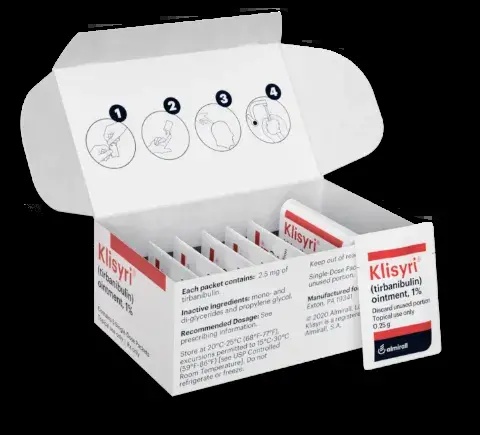

КЛИСИРИ 10 мг/г МАЗЬ

Спросите врача о рецепте на КЛИСИРИ 10 мг/г МАЗЬ

Инструкция по применению КЛИСИРИ 10 мг/г МАЗЬ
Введение
Прошу: информация для пациента
Klisyri 10 мг/г мазь
тирбанибулина
Этот препарат подлежит дополнительному наблюдению, что ускорит обнаружение новой информации о его безопасности. Вы можете внести свой вклад, сообщая о нежелательных реакциях, которые у вас могут возникнуть. В конце раздела 4 содержится информация о том, как сообщать о этих нежелательных реакциях.
Прочитайте внимательно весь листок-вкладыш перед началом использования этого препарата, поскольку он содержит важную информацию для вас.
- Сохраните этот листок-вкладыш, поскольку вам может потребоваться снова прочитать его.
- Если у вас есть какие-либо вопросы, проконсультируйтесь с вашим врачом или фармацевтом.
- Этот препарат назначен вам, и не передавайте его другим людям, даже если у них такие же симптомы, как у вас, поскольку он может нанести им вред.
- Если вы испытываете нежелательные реакции, проконсультируйтесь с вашим врачом или фармацевтом, даже если это нежелательные реакции, которые не указаны в этом листке-вкладыше. См. раздел 4.
Содержание листка-вкладыша
- Что такое Klisyri и для чего он используется
- Что вам нужно знать перед началом использования Klisyri
- Как использовать Klisyri
- Возможные нежелательные реакции
- Хранение Klisyri
- Содержание упаковки и дополнительная информация
1. Что такое Klisyri и для чего он используется
Klisyri содержит активное вещество тирбанибулина. Он используется для лечения легкой актинической кератозы у взрослых. Актиническая кератоза представляет собой шероховатую область кожи, которая развивается у людей, которые длительное время подвергались воздействию солнца. Klisyri следует использовать только для лечения плоской актинической кератозы лица и скальпа.
2. Что вам нужно знать перед началом использования Klisyri
Не используйте Klisyri
- если вы аллергичны к тирбанибулине или любому другому компоненту этого препарата (перечисленному в разделе 6).
Предостережения и меры предосторожности
Проконсультируйтесь с вашим врачом или фармацевтом перед началом использования Klisyri
- Не используйте Klisyri до тех пор, пока область, подлежащая лечению, не заживет после любого предыдущего лечения, процедуры или хирургического вмешательства. Не наносите Klisyri на открытые раны или поврежденную кожу.
- Мойте руки, если вы трогаете область, где была нанесена мазь.
- Не допускайте попадания Klisyri в глаза. В случае случайного попадания в глаза промойте их большим количеством воды, обратитесь за медицинской помощью как можно скорее и возьмите с собой этот листок-вкладыш.
- Не наносите мазь на внутренние области тела, внутри носовых полостей, во внутреннее ухо или на губы. В случае случайного попадания мази на любую из этих областей, промойте ее водой.
- Не принимайте этот препарат внутрь. В случае случайного приема этого препарата выпейте много воды, обратитесь за медицинской помощью и возьмите с собой этот листок-вкладыш.
- Сообщите вашему врачу, если у вас есть проблемы с иммунной системой.
- Следите за появлением новых красных и чешуйчатых пятен, открытых язв и бородавчатых или выпуклых поражений вокруг области лечения. Если вы заметите любое из них, немедленно проконсультируйтесь с вашим врачом.
- После использования Klisyri избегайте занятий, которые могут вызвать чрезмерное потоотделение, а также воздействие солнечного света в medida de lo posible (включая солнечные лампы и солярии). Когда вы находитесь на улице, носите защитную одежду и шляпу.
- Не закрывайте область, подлежащую лечению, повязкой после нанесения Klisyri.
- Не наносите больше мази, чем рекомендовал ваш врач.
- Не наносите мазь более одного раза в день.
- Не допускайте, чтобы домашние животные или другие люди трогали область, подлежащую лечению, в течение примерно 8 часов после нанесения мази. Если вы трогаете область, подлежащую лечению, вымойте область контакта другого человека или домашнего животного.
- Свяжитесь с вашим врачом, если вы испытываете кожные реакции на этот препарат в области, подлежащей лечению, которые ухудшаются (см. раздел 4).
Дети и подростки
Не давайте этот препарат детям и подросткам младше 18 лет, поскольку они не развивают актиническую кератозу.
Другие препараты и Klisyri
Сообщите вашему врачу или фармацевту, если вы используете, недавно использовали или можете использовать любой другой препарат.
Если вы ранее использовали Klisyri или подобные препараты, сообщите вашему врачу перед началом лечения.
Беременность, лактация и фертильность
Если вы беременны или кормите грудью, считаете, что можете быть беременной или планируете стать беременной, проконсультируйтесь с вашим врачом перед использованием этого препарата.
Klisyri не должен использоваться во время беременности.
Вождение и использование машин
Не ожидается, что этот препарат повлияет на вашу способность управлять транспортными средствами или использовать машины.
Klisyri содержит пропиленгликоль
Пропиленгликоль может вызвать раздражение кожи.
3. Как использовать Klisyri
Следуйте точно инструкциям по применению этого препарата, указанным вашим врачом. В случае сомнений проконсультируйтесь с вашим врачом или фармацевтом.
Этот препарат показан для лечения максимальной области 25 см² в течение одного цикла лечения в течение пяти дней. Если область, подлежащая лечению, не показывает полного очищения примерно через 8 недель после начала цикла лечения или если на ней появляются новые поражения, ваш врач должен пересмотреть продолжение этого лечения и рассмотреть другие терапевтические варианты.
Нанесите тонкий слой Klisyri на пораженную область лица или скальпа один раз в день в течение 5 последовательных дней. Каждый пакет содержит достаточно мази, чтобы покрыть область, подлежащую лечению. Не храните открытый пакет для использования в другой день, даже если в нем еще осталась мазь.
Инструкции по применению:
- Мойте руки водой и мылом перед нанесением мази.
- Мойте область, подлежащую лечению, водой и нейтральным мылом и осторожно высушите.
- Открывайте новый пакет каждый раз, когда вы собираетесь нанести этот препарат.
- Открывайте пакет по перфорированной линии (рисунок 1).
- Нанесите немного мази на кончик пальца (рисунок 2).
- Равномерно нанесите тонкий слой мази на всю область, подлежащую лечению (рисунок 3).
- Мойте руки водой и мылом сразу после нанесения мази (рисунок 4).
- Не мойте и не трогайте область, подлежащую лечению, в течение примерно 8 часов. После этого периода вы можете мыть область, подлежащую лечению, водой и нейтральным мылом.
- Не закрывайте область, подлежащую лечению, повязкой после нанесения Klisyri.
- Повторяйте предыдущие шаги каждый день лечения примерно в одно и то же время.

Если вы используете больше Klisyri, чем должно быть
Мойте область, подлежащую лечению, водой и нейтральным мылом. Проконсультируйтесь с вашим врачом или фармацевтом, если у вас есть сильные кожные реакции.
Если вы забыли использовать Klisyri
Если вы забыли одну дозу, нанесите мазь, как только вы вспомните, и затем продолжайте свою обычную схему лечения. Не наносите мазь более одного раза в день.
Если у вас есть какие-либо другие вопросы о использовании этого препарата, проконсультируйтесь с вашим врачом или фармацевтом.
4. Возможные нежелательные реакции
Как и все препараты, этот препарат может вызывать нежелательные реакции, хотя не все люди испытывают их.
После использования этого препарата вы можете испытывать нежелательные реакции в области кожи, где была нанесена мазь. Эти нежелательные реакции могут ухудшаться до 8 дней после начала лечения и, как правило, исчезают в течение 2-3 недель после окончания лечения. Проконсультируйтесь с вашим врачом, если эти нежелательные реакции ухудшаются.
Наиболее частые нежелательные реакции в области, подлежащей лечению:
Очень частые(могут возникать у более 1 из 10 человек)
- покраснение (эритема)
- отслоение кожи (эксфолиация)
- корочки (энкостация)
- отек
- потеря верхнего слоя кожи (эрозия, язва)
Другие возможные нежелательные реакции в области, подлежащей лечению:
Частые(могут возникать у до 1 из 10 человек)
- боль (боль при пальпации, жжение или ощущение жара)
- зуд (прурит)
- пузырьки (везикулы, пустулы)
Сообщение о нежелательных реакциях
Если вы испытываете любой тип нежелательной реакции, проконсультируйтесь с вашим врачом или фармацевтом, даже если это возможные нежелательные реакции, которые не указаны в этом листке-вкладыше. Вы также можете сообщать о них напрямую через систему фармаковигиланса для лекарственных средств для человека: https://www.notificaram.es. Сообщая о нежелательных реакциях, вы можете внести свой вклад в предоставление более полной информации о безопасности этого препарата.
5. Хранение Klisyri
Храните этот препарат в недоступном для детей месте.
Не храните в холодильнике или морозильнике.
Не используйте этот препарат после даты истечения срока годности, указанной на коробке и этикетке после CAD. Дата истечения срока годности - последний день месяца, указанного.
Для одноразового использования. Не повторно используйте пакеты после их открытия.
Лекарственные препараты не должны выбрасываться в канализацию или мусор. Спросите вашего фармацевта, как утилизировать упаковку и лекарственные препараты, которые вам больше не нужны. Таким образом, вы поможете защитить окружающую среду.
6. Содержание упаковки и дополнительная информация
Состав Klisyri
- Активное вещество - тирбанибулина. Каждый пакет содержит 2,5 мг тирбанибулины в 250 мг мази. Каждый грамм мази содержит 10 мг тирбанибулины.
- Другие компоненты - пропиленгликоль и моноэстерат глицерина 40-55.
Внешний вид продукта и содержание упаковки
Каждый пакет Klisyri содержит 250 мг белой или слегка белесой мази. Каждая коробка содержит 5 пакетов из полиэтилена/фольги.
Владелец разрешения на продажу
Almirall, S.A.
Ronda General Mitre, 151
08022 Барселона
Испания
Производитель
Almirall Hermal GmbH Scholtzstrasse 3
21465 Reinbek
Германия
Вы можете получить больше информации о этом препарате, обратившись к местному представителю владельца разрешения на продажу:
Almirall, S.A. Тел: +34 93 291 30 00 | |
Дата последнего обновления этого листка-вкладыша: 07/2021
Подробная информация о этом препарате доступна на сайте Европейского агентства по лекарственным средствам: http://www.ema.europa.eu.

Сколько стоит КЛИСИРИ 10 мг/г МАЗЬ в Испании в 2025 году?
Средняя цена на КЛИСИРИ 10 мг/г МАЗЬ в ноябрь, 2025 года составляет около 75.95 евро. Финальная стоимость может зависеть от региона, конкретной аптеки и рецептурного статуса. Для точной информации лучше проверить онлайн или в ближайшей аптеке.
- Страна регистрации
- Средняя цена в аптеках75.95 EUR
- Активное вещество
- Требуется рецептДа
- Производитель
- Информация носит справочный характер и не является медицинской рекомендацией. Перед приемом любых препаратов проконсультируйтесь с врачом. Oladoctor не несет ответственности за медицинские решения, принятые на основе этого контента.
- Аналоги КЛИСИРИ 10 мг/г МАЗЬФорма выпуска: ГЕЛЬ, 7,5 мг/гАктивное вещество: МетронидазолПроизводитель: Laboratorios Vinas S.A.Требуется рецептФорма выпуска: ГЕЛЬ, 7,5 мг/гАктивное вещество: МетронидазолПроизводитель: Laboratorios Galderma S.A.Требуется рецептФорма выпуска: КРЕМ, 50 мг/гАктивное вещество: ацикловирПроизводитель: Aristo Pharma Iberia S.L.Требуется рецепт
Аналоги КЛИСИРИ 10 мг/г МАЗЬ в других странах
Лучшие аналоги с тем же действующим веществом и терапевтическим эффектом.
Аналог КЛИСИРИ 10 мг/г МАЗЬ в Украина
Врачи онлайн по КЛИСИРИ 10 мг/г МАЗЬ
Консультация по дозировке, побочным эффектам, взаимодействиям, противопоказаниям и продлению рецепта на КЛИСИРИ 10 мг/г МАЗЬ – по решению врача и с учетом местных правил.






